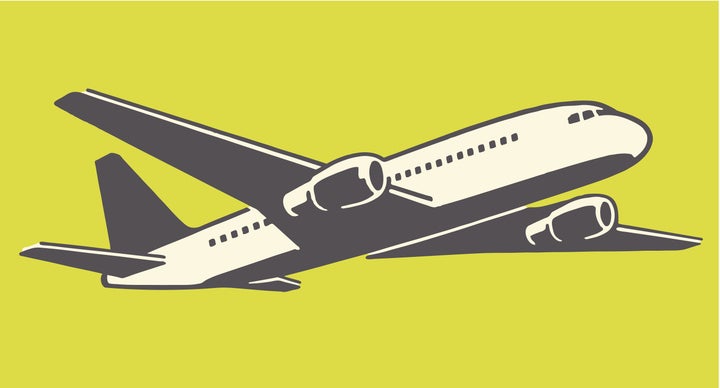We’re here to guide you through the coronavirus pandemic. Sign up to the Life newsletter for daily tips, advice, how-tos and escapism.
As fellow Brits pile on planes headed for tropical destinations, many of you will be wondering whether you, too, should book a last-minute summer getaway.
One of the things that might be holding you back – in addition to the prospect of quarantine on return – is getting on a plane. Being contained on an airtight vessel with strangers (and their germs) for hours doesn’t sound like the most ‘Covid secure’ environment.
Historically, studies have found planes can be breeding grounds for infectious diseases – add into the mix the prospect of a potentially airborne illness and it doesn’t fill a person with hope. So, is the air safe on a plane?
Professor Qingyan Chen, an expert in mechanical engineering at Purdue University, tells HuffPost UK while coronavirus could be airborne – and therefore may spread through air conditioning systems – “the virus concentration in air is very low”. But if you’re exposed to a low virus concentration in the air for a long time, there’s a higher risk of becoming infected.

Generally it’s believed the filters used on aircrafts, called high efficiency particulate air (HEPA) filters, do a good job of filtering out particles the size of Covid-19.
“The interesting thing is there haven’t been documented cases of transmission on airlines,” says Professor David Hunter, an expert in epidemiology in the Nuffield Department of Population Health at University of Oxford. “My guess is that’s probably because most of the airlines... have been flying mostly empty.”
While flying isn’t without its risks, Prof Hunter says right now, the destination is likely to be more risky anyway. “If someone’s travelling, depending on where they’re travelling to, they’re probably at greater risk of picking up the virus when they spend a couple of weeks in the other destination, than they are to get it on the plane.”
The Foreign & Commonwealth Office currently advises Brits against all but essential international travel – but travel to some countries is exempt from this advice, including France, Croatia and Italy.
When travelling on a plane during the pandemic, people are advised to: remain seated as much as possible; follow instructions and guidance from crew; use contactless payment where possible; be aware there’s likely to be a reduced food and drink service; and make the cabin crew aware if you become ill.
There are other things you can do to reduce your risk of catching the virus on a flight.
Opt for a shorter flight
Professor Hunter says one of the key factors to consider is how long you’re flying for. Shorter flights – for example, a one-hour flight – pose less of a risk than, say, a four-hour flight.
Fly at quieter times, if you can
If there are hardly any people on your flight, the risk is automatically lowered as there are fewer people to catch the virus from. You might want to discuss quieter times with the airline before booking – although nothing can be guaranteed.
“I wouldn’t want to be on a plane that’s choc-a-block,” says Prof Hunter. “I’d feel relatively safe on a plane where they’re flying three quarters empty and they’ve spaced people out.”
Sit at a distance from others
Where you’re seated – and how far away you’re sat from others – is important. If people are spread out, it would be safer than if you have to sit right next to, or directly in front of, someone.
A FlyHealthy study conducted by researchers from Emory University in 2018 found an infectious passenger with influenza was unlikely to transmit infection to passengers seated further away than two seats laterally and one row in front or behind. If you’re seated close to someone, ask if you can move.
A preprint study about Covid-19 transmission on planes suggested when all seats are full on a US jet aircraft, the risk of contracting Covid-19 from a nearby passenger is about 1 in 7,000. But if the middle seat is left empty, that risk falls to about 1 in 14,000.
Keep your hands clean and don’t touch your face
The same study about Covid-19 transmission discovered another key mode of transmission was touching infected surfaces such as tray tables, seat belts and lavatory handles. This is one of the primary ways to catch Covid-19.
“Passengers and flight crews can eliminate this risk of indirect transmission by exercising hand hygiene and keeping their hands away from their nose and eyes,” the researchers suggested. The same rules apply now, keep those mitts clean (hand sanitiser is your friend on flights) and do not touch your face.
It might be worth taking some cleaning wipes with you to wipe down the seatbelt, armrests and tray tables.
Wear a face cover
“To protect from infection, it’s important that everyone wears masks,” says Prof Chen. Different airlines have different measures in place surrounding mandatory face coverings, although most will require you to wear one.
If everyone wore a mask, theoretically, that means fewer droplets will escape from people’s noses and mouths into the environment – and there will be less of a temptation to touch your face.
Government advice states you can remove your face covering to: communicate with someone who relies on lip reading; avoid harm or injury; take medication and eat or drink (if reasonably necessary).
